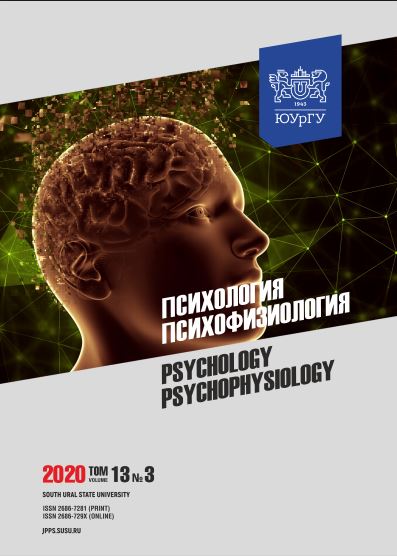DRIVERS PERCEPTION OF TIME AS A FACTOR OF ROAD SAFETY
Abstract
Background. One of the ways to reduce road traffic accident rate is to improve the driver's reliability by training his/her psychophysiological fitness. The most important parameter of human psychophysiology that affects the accuracy of road situation analysis is the perception of time. Aim. The paper aims to determine the features of time perception by drivers depending on their gender, age, general psychophysiological fitness and driving experience. Materials and methods. The results of a survey of 1000 driving school students and 500 professional drivers were used during the study. Participants were divided into four equal age groups of both sexes. The representativeness of a random sample was achieved in accordance with the method of prof. D. Mannheim separately for males and females, as well as for adolescents, young and mature people. The primary indicators were determined using the UPDK-MK Avtomobilny (Neurokom) hardware and software complex for testing the psychophysiological qualities of the driver. The data obtained were presented in the form of distribution of the surveyed according to the level of time perception depending on gender, age, driving experience and the level of psychophysiological fitness. Results. A low level of accuracy of time perception was found in the majority of participants regardless of their age, gender and driving experience. The share of persons with a satisfactory and unsatisfactory level of accuracy averaged 61% among driving school students and 56% among professional drivers, practically regardless of age. Psychophysiological fitness was of significant importance: in persons with a high level of it, the “very good” mark for the accuracy of time perception was 2.5 times higher. Conclusion. To improve the perception of time by a person and to increase road safety, it is necessary to intentionally train general psychophysiological fitness of a person and his/her perception of time.
Downloads
References
2. Alekseyev L.A., Kuznetsov Yu.A. [Driver physiology and its impact on road safety]. Avtotransportnoye predpriyatiye [Motor transport enterprise], 2014b, no. 1, pp. 16–18. (in Russ.).
3. Belinskaya E.P., Davy`dova I.S. [Сottles grahyic test: specifics of time perspective indices]. Psikhologicheskaya nauka i obrazovanie [Psychological Science and Education], 2007, no. 5, pp. 28–36. (in Russ.).
4. Bulynko O.V. [Perception of the traffic situation as the factor of safety]. Vestnik universiteta grazhdanskoi zashchity MChS Belarusi [Journal of Civil Protection], 2019, vol. 3, no. 1, pp. 67–73. (in Russ.).
5. Denisov E.I., Stepanyan I.V., Melnik M.S. [Evaluation of information visual load on the car driver]. Meditsina truda i promyshlennaya ekologiya [Russian Journal of Occupational Health and Industrial Ecology], 2020, vol. 60, no. 2, pp. 136–140. DOI: 10.31089/1026-9428-2020-60-2-136-140 (in Russ.).
6. Zubova L.V., Ryzhukhin A.V. [Features of time perception: the complexity of the problem]. Fundamentalnye issledovaniya [Fundamental study], 2008, no. 10, pp. 64–66. (in Russ.).
7. Lyandenburskii V.V., Ilina I.E., Pylaikin S.A., Ekimov P.M. [Quantitatively-time analysis of “gross violations” men and women on a road simulator]. Internet-zhurnal “Naukovedenie” [The online journal “Naukovedenie”], 2015, vol. 7, no. 5 (30), pp. 138. DOI: 10.15862/17TVN515 (in Russ.).
8. Kotovskaya S.V., Mosyagin I.G. [Correlation Between the Functional Status and Viability in the Subjects Involved in Extreme Activities]. Psikhologiya. Psikhofiziologiya [Psychology. Psychophysiology], 2019, vol. 12, no. 3, pp. 64–71. DOI: 10.14529/jpps190306 (in Russ.).
9. Kostandov E.A., Zakharova N.N., Vazhnova T.N. i dr. [Distinguishing microintervals of time by emotionally excitable individuals]. Zhurnal vysshei nervnoi deyatelnosti im. I.P. Pavlova [I.P. Pavlov Journal of Higher Nervous Activity]. 1988, vol. 38, no. 4, p. 614. (in Russ.).
10. Surnina O.E., Antonova N.V. [Features of time perception by elderly people]. Psikhologicheskii vestnik Uralskogo gosudarstvennogo universiteta [Psychological Bulletin of the Ural State University], 2003, no. 4, pp. 195–203. (in Russ.).
11. Tushnova T.V. [About memory for time in children of different school age. Physiological mechanisms of perception and evaluation of time]. Uchenye zapiski Bashkirskogo gosudarstvennogo universiteta [Scientific notes of the Bashkir state University], 1968, is. 24, no. 3, pp. 128–133. (in Russ.).
12. Bowen L., Budden S.L., Smith A.P. Factors underpinning unsafe driving: A systematic literature review of car drivers. Transportation Research Part F: Traffic Psychology and Behaviour, 2020, vol. 72, pp. 184–210. DOI: 10.1016/j.trf.2020.04.008.
13. Edwards A.M., McCormick A. Time perception, pacing and exercise intensity: maximal exercise distorts the perception of time. Physiology & Behavior, 2017, vol. 180, pp. 98–102. DOI: 10.1016/j.physbeh.2017.08.009
14. Kadlub E.A. Time: language and substance. Percept, and Motor Skills, 1996, vol. 83, no. 3 (pt. 1), pp. 903–913.
15. Lin C.-C. Effects of illumination, viewing distance, and lighting color on perception time. Percept Mot Skills, 2003, vol. 96 (3 Pt.1), pp. 817–826. DOI: 10.2466/pms.2003.96.3.817
16. Recanzone G.H. Interactions of auditory and visual stimuli in space and time. Hear Res, 2009, vol. 258 (1-2), pp. 89–99. DOI: 10.1016/j.heares.2009.04.009
17. Sarbaz Y., Pourakbari H. How perception of time differs under different situations: Different behaviors of the central nervous system as a complex dynamic system. Psychiatry and clinical neurosciences, 2020, vol. 74, is. 1, pp. 86–87. DOI: 10.1111/pcn.12953
18. Wu K.-F., Lin Y.-J. Exploring the effects of critical driving situations on driver perception time (PT) using SHRP2 naturalistic driving study data. Accident Analysis & Prevention, 2019, vol. 128, pp. 94–102. DOI: 10.1016/j.aap.2019.04.003
References on translit
-Copyright (c) 2020 Psychology. Psychophysiology

This work is licensed under a Creative Commons Attribution-NonCommercial-NoDerivatives 4.0 International License.



